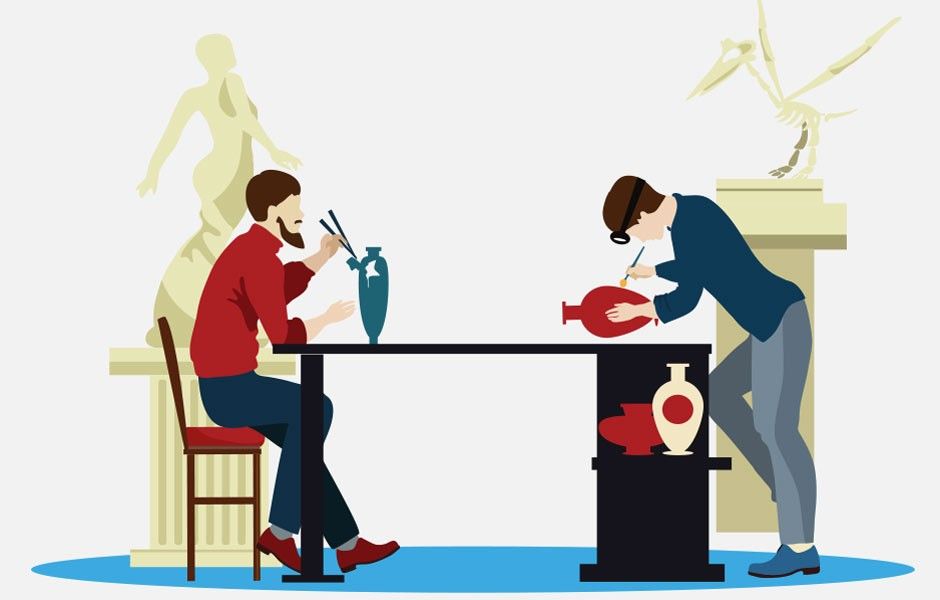Get the Most from Your Institution’s Collections Data
Tracking object details is an essential part of collections care. Adhering to a strong set of collections information and cataloguing standards through institutional collections management policies can help preserve the history of your collection for the future, and make your department’s day-to-day activities more efficient—from preparing exhibition lists to managing conservation tasks.
Terms of the Trade
Collections Management Policy
Collections management policies are put into place to ensure a collections institution or museum outlines a foundation of how the organization handles its collections. These policies inform staff on how to handle and care for the collection and would answer questions such as protocols for removing or loaning objects from the collection to ensure no missteps along in the process.
Every collections management policy starts with an introduction which highlights the museum’s mission statement. This statement for the organization’s existence enforces the museum’s purpose and responsibilities to the public and its collection. Museums in the United States must have their mission statements adhere to the standards of the American Alliance of Museums.
The introduction also includes a selection criterion which outlines the priorities of which the organization applies for the acquisition of new objects in its collection. The rest of the policy usually covers the following:
- Acquisitions
- Deaccessions (object removal from the collection)
- Loans
- Care of collections
- Storage
- Integrated pest management
- Conservation
- Record management and documentation
- Inventories
- Risk management
Collections Documentation
Permanent records and supporting evidence of care during the lifetime of a collection. This includes, but is not limited to, the acquisition, preservation, conservation, management, display, and intellectual use of each object. Collections documentation helps to protect and secure the data and information of the collection.
Object Cataloguing
Recording the history, description, and details of an object. Object cataloguing also includes documenting details of an object’s life, such as accessioning, location changes, condition reports, handling requirements, exhibition history, and loan history.
A catalogue record will include:
- A unique identifying number that links the record to the object, usually the object’s accession number
- Object title or name
- Artist or maker of the object
- Cultural affiliation of artist or maker
- Geographic place names for site manufacture
- Object provenance
- Object dimensions
- Materials
- Classification
- Condition
- Location of the object
A Collections Management System (CMS)
A CMS is a software system designed to catalogue and manage collection objects, publish online collections, plan and manage exhibitions and loans, organize conservation documentation, and manage digital assets. Object care is enhanced by good collections management policies and a strong CMS. Creating a digital strategy for your institution using a CMS allows the user to sort and manage collections data more efficiently than with a manual system.
Relational collections management systems manage data in separate tables that are related to one another by a common field, like an accession number. Relational database systems have many advantages, such as one-to-many relationships (for instance, a single artist that is linked to many objects). In this type of database structure, data only needs to be entered once.
Structuring and Entering your Information
Data management reaps the greatest benefits when data is consistent and controlled, which can be achieved through museum-wide collections management policies. It’s important to focus on how information is structured and entered into the CMS.

These data standards enable consistent and reliable ways to search for similar objects. Please note that standards are dependent on the needs of each institution and collection.
- Data structure standards
• Determine the information you want to record.
• Identify which fields are essential and which are optional. - Data content standards
• What content or information should be entered into each field?
• Determine formatting guidelines for data fields, including style, grammar, and acceptable abbreviations. - Data value standards
• Decide the terminology or acceptable value for each field and authority to guarantee consistency over time.
Controlling Terminology
Controlling terminology in a CMS helps to keep information consistent, resulting in reliable and accurate query results. Not all fields need controlled vocabulary, but it should be applied to fields that are used for indexing and queries, such as:
- Classification (paintings, drawings, ceramics, etc.)
- Locations (Gallery 1, Gallery 2, etc.)
- Overall condition (excellent, good, fair, poor, etc.)
Resources for Terminology Standards
These resources were created to encourage the use of standard terms and reference resources, and provide structured vocabularies for recorded information. These assets help to facilitate object discovery during the search process.
- Art and Architecture Thesaurus (AAT), Getty Research Institute
- Union List of Artist Names (ULAN), Getty Research Institute
- Thesaurus of Geographic Names (TGN), Getty Research Institute
- Cultural Objects Name Authority (CONA), Getty Research Institute
- Chenhall’s Nomenclature
Creating Supporting Policies
Establishing museum-wide collections management policies is a necessary step to assure access and control of collections information. These policies include:
Maintenance and Authority Policy
- Identify staff members who have authority to add, modify, or delete records.
- Decide on procedures for editing collections information.
- Decide who will maintain database backups, the frequency, and manner.
Access Authority Policy
- Decide who has access to view and use collections information.
Data Standards Policies
- Document the new database record structure guidelines for staff. Be sure to point out mandatory fields, and the content and format for each field.
- Share the guides with museum staff to help protect the institution against data loss.
- Make the guides easily accessible for the future.
The Benefits of Applying Data Standards

The new museum-wide policies and data standards that have been developed will keep data updated and secure, while lessening the staff’s workload. Staff will benefit from:
- Increased access to records
- Consistent retrieval of information
- Increased quality and accuracy of data
- Data that is easily adapted to new technological developments or documentation
- Data that can be efficiently exported into another system
- The ability to easily exchange data with other institutions
- Data that can be easily published on the web
Resources on Cataloguing Standards
Researching the cataloguing standards developed by members of the museum community can help you to create the best possible standards for your collection.
Here are a couple examples of international cataloguing standards:
- CIDOC – ICOM International Committee for Documentation (CIDOC)
- Categories for describing works of art (CDWA and CDWA Lite)
- Cataloging Cultural Objects (CCO)
Proper collections documentation and cataloguing practices can help you gain more control over your collection data, which helps achieve your museum’s mission better by making collection objects and data more accessible to your staff and the public.
Staff will find that their workflows for exhibitions planning, loans and outgoing objects, conservation documentation, and other regular tasks are simplified. When object data is digitally documented in a CMS, it helps future-proof the collection and prepares the collection for things like online exhibitions or the integration mobile apps.
Partnering with the right collections management system provider to support your collection will help you to structure your data so your institution and staff can thrive. The right tools and support can easily become the key to collections success. Interested in learning more? Read our guide Choosing the Right Museum CMS.






